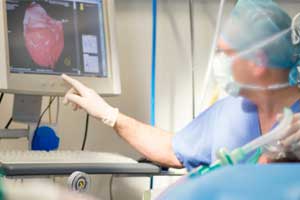- Home
- Editorial
- News
- Practice Guidelines
- Anesthesiology Guidelines
- Cancer Guidelines
- Cardiac Sciences Guidelines
- Critical Care Guidelines
- Dentistry Guidelines
- Dermatology Guidelines
- Diabetes and Endo Guidelines
- Diagnostics Guidelines
- ENT Guidelines
- Featured Practice Guidelines
- Gastroenterology Guidelines
- Geriatrics Guidelines
- Medicine Guidelines
- Nephrology Guidelines
- Neurosciences Guidelines
- Obs and Gynae Guidelines
- Ophthalmology Guidelines
- Orthopaedics Guidelines
- Paediatrics Guidelines
- Psychiatry Guidelines
- Pulmonology Guidelines
- Radiology Guidelines
- Surgery Guidelines
- Urology Guidelines
Lung ultrasound better than X-Ray at detecting complications after CT surgery

Lung Ultrasound may be used as the primary imaging technique for the diagnosis of postoperative pulmonary complications after cardiothoracic surgery, suggests a prospective, observational and single-center study.
Findings of the study published in the journal Anaesthesia determined that lung ultrasound facilitated bedside decision making and showed utility in detecting postoperative pulmonary complications.
H. R. Touw, VU University Medical Center Amsterdam, the Netherlands, and colleagues conducted the study to compare the diagnostic accuracy of lung ultrasound with that of chest X-ray to detect postoperative pulmonary complications in adult patients who had undergone cardiothoracic surgery.
Postoperative pulmonary complications are common after cardiothoracic surgery and are associated with adverse outcomes. The ability to detect postoperative pulmonary complications using chest X‐rays is limited, and this technique requires radiation exposure. Little is known about the diagnostic accuracy of lung ultrasound for the detection of postoperative pulmonary complications after cardiothoracic surgery.
The study was performed in a tertiary intensive care unit treating adult patients who had undergone cardiothoracic surgery. On admission and on postoperative days 2 and 3, chest X-ray findings were recorded in addition to rates of postoperative pulmonary complications and clinically-relevant postoperative pulmonary complications that required therapy according to the treating physician as part of their standard clinical practice. An independent researcher performed lung ultrasound at the time of chest X-ray. Comparisons between lung ultrasound and chest X-ray were carried out with respect to the detection of postoperative pulmonary complications and clinically-relevant postoperative pulmonary complications. Inter-observer agreement for lung ultrasound as well as the time to perform both imaging techniques were evaluated. Using subgroup analyses, the time to detection of clinically-relevant postoperative pulmonary complications by both modalities was compared.
Key Findings:
- Data showed a total of 177 patients underwent both lung ultrasound and chest X-ray imaging.
- Lung ultrasound vs chest X-ray identified 159 (90%) vs 107 (61%) postoperative pulmonary complications on the day of admission, respectively.
- The presence of clinically-relevant postoperative pulmonary complications was detected by lung ultrasound in 11 out of 17 patients (65%) and by chest X-ray in 7 out of 17 patients (41%).
- Lung ultrasound vs chest X-ray provided earlier detection of clinically-relevant postoperative pulmonary complications.
- An excellent inter-observer agreement was observed for lung ultrasound.
- Lung ultrasound vs chest X-ray detected more postoperative pulmonary complications and clinically-relevant postoperative pulmonary complications after cardiothoracic surgery, and at an earlier time-point.
"Our results suggest lung ultrasound may be used as the primary imaging technique to search for postoperative pulmonary complications after cardiothoracic surgery and will enhance bedside decision making, concluded the authors.
For further reference log on to https://doi.org/10.1111/anae.14243

Disclaimer: This site is primarily intended for healthcare professionals. Any content/information on this website does not replace the advice of medical and/or health professionals and should not be construed as medical/diagnostic advice/endorsement or prescription. Use of this site is subject to our terms of use, privacy policy, advertisement policy. © 2020 Minerva Medical Treatment Pvt Ltd